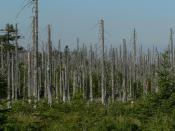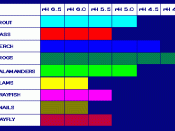INTRODUCTION
The term acid rain is usually used to refer to rain or snow with pH less than 5.6. It is
usually created because of the presence of nitric and/or sulfuric acid in the atmosphere and it also
affects everything it touches, including buildings, plants, and even seeds. Acid rain can affect seed
germination. Seed germination is when the seed begins to grow . A radicle can seen, as the seed
begins to split apart.
ACIDS
In order to understand acid rain, pH must first be understood. pH determines a substance's
acidity. A pH scale goes from 0 to 14. The lower the pH, the higher the acidity. Acids also have
other distinguishable characteristics. Acids taste sour, from with bases to make salt, turn litmus
paper (pH paper) red, and strong acids can burn skin. (National Atlantic Quebec Ontario Prairies
http://www.ec.gc.ca/acidrain/acidfact.html)
0 = most acidic
7 = neutral point (middle of the scale)
14 = most alkalinic (least acidic)
The pH level is based on a logarithmic scale.
Every step on the pH scale represents a
factor of 10. pH 1 is 10 times more acidic than 2. (Somerville, Richard C.J. pg. 144)
Since acids release hydrogen ions, pH is based on the concentration of hydrogen ions in
the solution. (National Atlantic Quebec Ontario Prairies http://www.ec.gc.ca/acidrain/acidfact.html)
ACID RAIN
Rainwater naturally has a pH of 5.5 - 6, because carbon dioxide naturally dissolves in it,
but acid rain is man made and much more acidic. Acid rain is caused by the presence of sulfur
dioxide (SO2) and/or nitrogen oxide (NOx) in the atmosphere, where clouds form. Then as rain or
snow is formed, it falls to the ground and is mixed with the NOx and/or SO2. As this acidic water
flows over the ground, damage is done to animals, plants, buildings,



Good work
This is a very thorough investigation on the \"Effect of Acid Rain on Seed Germination\". Good use of structure and its also good to see so many cited sources.
0 out of 0 people found this comment useful.